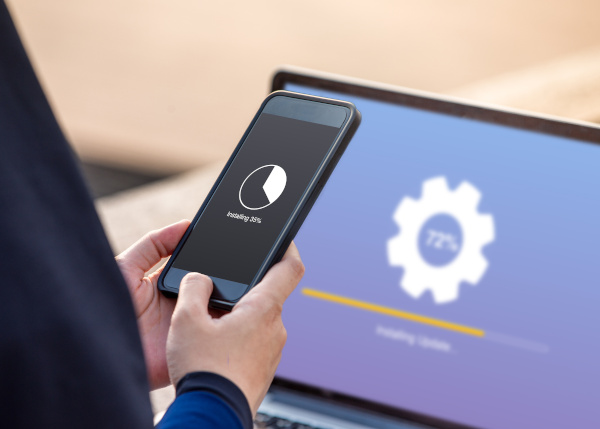In the post-pandemic world of hybrid offices and remote working the term 'softphone' has become far more common than it used to be. They've been around for a while, but if the term is new to you, then now might be a good time to find out more.
So What is a Softphone?
A softphone is essentially a phone which exists as downloadable software. It won’t be physically sent to you in the post. It exists as a program or app, the same as your CRM system, or a game on your phone.
How Will I Receive it?
You visit a certain website, click download, and the softphone is loaded on. There are two common versions of softphone, either for desktop PC or smartphone. Using whichever device you wish to use, you visit the appropriate website, and hit download. Your VoIP Provider will have sent you over the web address and any passwords required to initiate the download.
What are the Advantages?
One of the main advantages is freedom. A softphone allows for more flexibility than a standard deskphone, particularly if you choose a version which downloads onto your Smartphone. You then have the freedom to go where you want, any time, and know that your important calls will still reach you. You will present yourself in a way which reflects your company values – professional and business-like.
If you choose the Desktop version then you have the advantages of fewer wires cluttering your desk and work environment. You don’t incur the expense of shipping any hardware, or have to wait in for a courier driver to deliver anything.
Things to Think About
A softphone won’t completely replace an advanced deskphone altogether. If you regularly use soft keys to transfer calls, or handle a large volume of calls, then you may wish to consider a more advanced deskphone. Someone in a Receptionist role, for example, would probably be best served with a good deskphone, and perhaps a couple of expansion modules. Things like expansion modules or equipment to automatically hang up are not available for softphones.
How to Choose
If you have decided a softphone is the solution for you, then you need to decide which to go for. If you require to be out of the office, or don’t even have an office, then the smartphone version could work well for you. You can think of it as an office in your pocket. Your calls reach you, on your company number, wherever you are. You can have music on hold, recorded messages, company call routing, the works.
If you work in front of a PC, then there is a desktop PC softphone version for you. Using just a headset and a dial pad, your PC can double up as your company phone. It has the same company phone advantages as the smartphone, with all your company messages, routing and voicemail to email capabilities. Tied to a desktop PC, it is obviously less ‘mobile’ (if you’ll pardon the pun). But it does allow you a lower cost route in to a professional-sounding phone system, presenting your company in the best possible way, and making you stand out from the competition.
How to Buy
If you are won over by the idea of a softphone, and think one will work for you, then there are a number of suppliers out there. Firstly, you will need a VoIP phone service. If you don’t have one, you need to get one (there are a number of reasons for this, not least the flexibility one affords).
Once you have chosen a Hosted VoIP Provider, or if you already have a Hosted VoIP service in place, you need to think about a softphone. There are a number out there to choose from. Some are free to download, others are advanced with business use in mind. It is obvious, but it is well worth repeating, that the free to download ones will not give you as many features and functions as a paid for, business-grade softphone.
You need to decide if you require a more advanced one, and whether the smartphone or desktop PC version will work best for you. We always stand by purchasing a decent one from a reputable supplier. Free versions are there to hook you in, and tempt you into upgrading. As such they are often lacking in features that you may require. If it is to be used as part of your overall business communications, then it is worth investing in one which reflects your company well.
It is also worth while investing in one which works properly, works reliably, and gives a good range of features and benefits. The ability to transfer calls to a colleague, for instance, may sound like something you can do without, but let’s walk possible scenario through.
Your customer calls in, and you take the call. Everything’s fine so far, you exchange pleasantries, and you determine the nature of the call. It isn’t you that can help, but your business partner, or colleague. Now comes the tricky part. You need to give them another phone number, and explain that this person can help, and would they mind hanging up, and calling them instead? As a Marketing person, if that doesn’t have Potential Lost sale written all over it, I don’t know what does.
It might be a simplification, but we advise to buy a decent one from the beginning. It will pay for itself, in features and usability, if nothing else.
Working with your Softphone
Whichever version you go for, they are fundamentally quite simple to use. Your first step will be to download, just as you would for an app on your phone, or a new program on your PC. Remember, if you are using a desktop PC version, you will need a headset with a microphone.
If you have signed up with a reputable VoIP Provider, then all your softphones should be preconfigured ready for use.
Feel free to make a few test calls, either to your own mobile or to someone you know. Have them call back, or call yourself back, and see how it all works. Which button you hit to answer, which to transfer, which to put someone on hold.
You should see a dial pad on whichever device you are using, along with a row of buttons with various other functions. There will be a button to transfer a call, one to put someone on hold, one with your contacts listed.
If you and a team of other workers at your company are switching to using softphones at the same time then set aside some time to run through how it all works. Make some test calls, both inward and outward, and some transfers to other team members. This way, when your first customer call comes in, you won’t be caught out, feel stressed, or accidentally hang up.
If you feel your calls could be directed in a more effective way, then get in touch with your VoIP Provider, and start discussions regarding amendments to your company Ring Group. Remember your softphone will have individual user settings and features, but anything which fundamentally alters the way your overall phone system works will still only be changeable at the Provider end of your VoIP service.
You might also find useful:
Why you Shouldn’t Use your Personal Mobile for Work
If you’d like to discuss softphones, deskphones or anything else VoIP related, just get in touch.


Comments